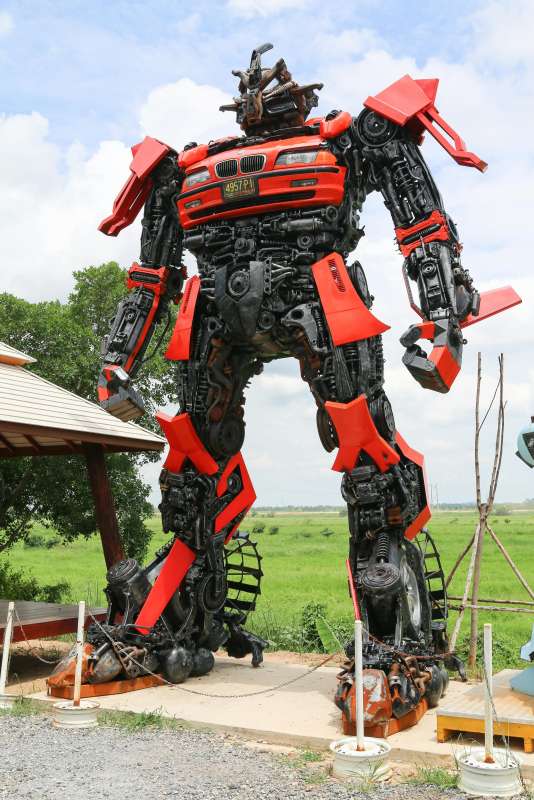Robotics in Construction: Automation of Building Processes
Published on: May 27, 2025
Robotics in Construction: Automation of Building Processes
Robotics has become a driving force in transforming the construction industry, which has traditionally relied on manual labor and time-consuming processes. The integration of robotics and automation in construction is reshaping how buildings are designed, constructed, and maintained. This technological evolution addresses several challenges faced by the sector, including labor shortages, safety concerns, project delays, and escalating costs. As robotics advances, it is increasingly being adopted to automate a variety of tasks on construction sites, from 3D printing of buildings to the use of autonomous vehicles for material transport. This shift not only increases efficiency but also enhances precision, safety, and sustainability throughout the construction lifecycle.
Current State of Robotics in Construction
The adoption of robotics in construction is still in its early stages compared to industries like manufacturing or automotive. However, the last decade has seen significant advancements. Robotics systems are now capable of performing tasks that were once deemed too complex for machines. Modern construction robots include bricklaying robots, welding robots, drones for site surveying, robotic arms for assembly, and autonomous vehicles for material handling. These technologies are being tested and implemented in pilot projects worldwide, with some already becoming standard practice on innovative construction sites.
One of the most prominent examples is the use of 3D printing robots to construct entire buildings. These robots extrude concrete or other building materials layer by layer, following digital blueprints. This process is not only faster than traditional construction methods but also reduces material waste and allows for the creation of complex architectural forms that would be difficult or expensive to achieve manually.
Autonomous vehicles and drones are also making significant contributions. Self-driving trucks and loaders transport materials across large construction sites, while drones conduct aerial surveys, monitor progress, and inspect hard-to-reach areas. These applications reduce the reliance on human labor for repetitive or hazardous tasks, minimizing the risk of injury and improving overall site safety.
3D Printing in Construction
3D printing, also known as additive manufacturing, is revolutionizing the construction sector. Unlike traditional construction, which involves assembling prefabricated or raw materials, 3D printing builds structures layer by layer based on a digital model. Large-scale 3D printers, often mounted on robotic arms or gantries, can construct walls, floors, and even entire buildings using specially formulated concrete or composite materials.
The benefits of 3D printing in construction are manifold. It enables rapid prototyping and customization, reduces material waste, and lowers labor costs. For instance, in 2017, a company in Russia used 3D printing to construct a 37-square-meter house in just 24 hours. Similar projects have been completed in the United States, China, and the United Arab Emirates, demonstrating the technology’s global reach and potential.
3D printing also opens up new possibilities for architectural design. Complex geometries, curves, and intricate patterns that would be difficult or prohibitively expensive to create using traditional methods can be realized with ease. This capability is particularly valuable in the construction of affordable housing, emergency shelters, and custom-designed buildings.
Furthermore, 3D printing can utilize sustainable materials, such as recycled plastics or locally sourced aggregates, contributing to the reduction of the environmental footprint of construction. As the technology matures and becomes more cost-effective, it is expected to play an increasingly important role in addressing housing shortages and promoting sustainable urban development.
Autonomous Vehicles and Material Handling Robots
Material transport and handling are critical aspects of any construction project. Traditionally, these tasks require significant human labor and are often associated with safety risks, especially when dealing with heavy loads or hazardous environments. The introduction of autonomous vehicles and robots for material handling is transforming this aspect of construction.
Autonomous vehicles, such as self-driving trucks, loaders, and forklifts, are equipped with sensors, cameras, and advanced navigation systems. They can transport materials across construction sites, deliver supplies to specific locations, and even remove debris, all without human intervention. These vehicles operate using GPS, lidar, and artificial intelligence algorithms to navigate complex and dynamic environments safely and efficiently.
Material handling robots, including robotic arms and mobile platforms, are used to lift, move, and position heavy components, such as steel beams, concrete panels, and prefabricated modules. These robots are often integrated with Building Information Modeling (BIM) systems, allowing them to follow precise instructions and coordinate with other automated systems on site.
The use of autonomous vehicles and robots for material handling offers several advantages. It increases productivity by allowing work to continue around the clock, reduces the risk of accidents and injuries, and minimizes delays caused by labor shortages or human error. In large-scale projects, these technologies can lead to substantial cost savings and improved project timelines.
Robotic Bricklaying and Assembly Systems
One of the most labor-intensive tasks in construction is bricklaying. Traditionally, skilled masons are required to lay bricks by hand, a process that is slow, physically demanding, and prone to inconsistencies. Robotic bricklaying systems have been developed to automate this process, increasing speed, accuracy, and quality.
Robotic bricklayers use advanced computer vision and robotic arms to pick up bricks, apply mortar, and place them precisely according to digital plans. Some systems can lay thousands of bricks per day, far surpassing the output of human workers. These robots are particularly useful for large-scale projects, such as commercial buildings, warehouses, and infrastructure developments.
In addition to bricklaying, robotic systems are being used for other assembly tasks, such as welding steel frames, installing windows, and assembling prefabricated components. These robots are often designed to work alongside human workers, augmenting their capabilities and reducing the physical strain of repetitive tasks.
The integration of robotic assembly systems with digital design tools allows for greater flexibility and customization. Changes to building plans can be implemented quickly, and robots can adapt to new instructions without the need for extensive retraining. This level of adaptability is crucial in today’s fast-paced construction environment, where projects often require rapid adjustments and on-the-fly problem-solving.
Drones in Construction: Surveying, Inspection, and Monitoring
Drones, or unmanned aerial vehicles (UAVs), have become indispensable tools in modern construction. They are used for a wide range of applications, including site surveying, progress monitoring, safety inspections, and mapping. Equipped with high-resolution cameras, lidar sensors, and thermal imaging devices, drones can capture detailed data from above, providing valuable insights that are difficult or impossible to obtain from the ground.
One of the primary uses of drones in construction is site surveying. Traditional surveying methods are time-consuming and labor-intensive, often requiring teams to manually measure and map large areas. Drones can cover vast sites in a fraction of the time, generating accurate 3D models and topographical maps. This data is used for site planning, earthworks, and progress tracking, helping project managers make informed decisions and identify potential issues early.
Drones are also used for safety inspections and monitoring. They can access hard-to-reach or hazardous areas, such as tall structures, bridges, or confined spaces, without putting workers at risk. By capturing real-time images and video, drones enable remote inspections and facilitate faster response to safety concerns.
Progress monitoring is another important application. Drones can conduct regular flyovers to document construction progress, compare actual work to project schedules, and provide visual evidence for stakeholders. This transparency improves communication, accountability, and project management.
Robotics for Demolition and Deconstruction
Demolition and deconstruction are essential phases of the construction lifecycle, particularly in urban environments where old structures must be removed to make way for new developments. These tasks are inherently dangerous, involving heavy machinery, hazardous materials, and unstable structures. Robotics is making demolition safer and more efficient by automating many of the most hazardous tasks.
Robotic demolition machines, often remotely operated or fully autonomous, are equipped with hydraulic arms, crushers, and cutting tools. They can selectively dismantle buildings, break down concrete, and separate materials for recycling. These robots are designed to operate in confined spaces and hazardous environments, reducing the risk to human workers.
Robotic deconstruction also supports sustainable construction practices. By enabling the selective removal of materials, robots facilitate recycling and reuse, minimizing waste and reducing the environmental impact of demolition. This approach aligns with the principles of the circular economy and supports efforts to create greener, more sustainable cities.
Integration with Digital Technologies: BIM and IoT
The effectiveness of robotics in construction is greatly enhanced by integration with digital technologies such as Building Information Modeling (BIM) and the Internet of Things (IoT). BIM is a digital representation of the physical and functional characteristics of a building, providing a shared knowledge base for all stakeholders. Robotics systems can interface with BIM to receive instructions, update progress, and synchronize activities with other automated systems on site.
IoT devices, including sensors and smart tags, are used to monitor equipment, track materials, and collect real-time data on site conditions. This information is used to optimize robot operations, schedule maintenance, and improve safety. For example, sensors can detect when a robot needs servicing or when materials are running low, triggering automatic responses to keep the project on track.
The combination of robotics, BIM, and IoT creates a connected construction ecosystem, where information flows seamlessly between digital models, automated machines, and human workers. This integration enables greater coordination, reduces errors, and supports data-driven decision-making throughout the construction process.
Challenges and Limitations of Robotics in Construction
Despite the many benefits, the adoption of robotics in construction faces several challenges. One of the main barriers is the high initial cost of robotic systems and the need for specialized training. Many construction companies, particularly small and medium-sized enterprises, may struggle to justify the investment, especially when project margins are tight.
Another challenge is the complexity of construction sites. Unlike factories, which offer controlled environments, construction sites are dynamic, unpredictable, and subject to changing weather, terrain, and logistics. Robots must be robust and adaptable to operate effectively in these conditions.
There are also concerns about job displacement. As robots take over repetitive or dangerous tasks, there is a risk that some construction jobs may become obsolete. However, many experts argue that robotics will create new opportunities for skilled workers, particularly in areas such as robot maintenance, programming, and supervision.
Regulatory issues and safety standards are additional considerations. The use of autonomous machines on construction sites raises questions about liability, insurance, and compliance with local regulations. Industry stakeholders are working with regulators to develop guidelines and best practices for the safe and effective deployment of robotics in construction.
Future Trends and Innovations in Construction Robotics
The future of robotics in construction is marked by rapid innovation and increasing adoption. Advances in artificial intelligence, machine learning, and sensor technology are enabling robots to perform more complex tasks with greater autonomy and precision. Collaborative robots, or cobots, are being developed to work safely alongside human workers, combining the strengths of both.
Emerging trends include the use of modular construction, where robots assemble prefabricated modules off-site and transport them for final installation. This approach reduces construction time, improves quality control, and minimizes disruption to surrounding areas. Swarm robotics, inspired by the collective behavior of insects, is another area of research, with groups of small robots working together to accomplish large tasks.
Robotics is also playing a role in sustainable construction. Robots are being developed to build with eco-friendly materials, optimize energy use, and minimize waste. For example, robots can construct green roofs, install solar panels, and create energy-efficient building envelopes.
As technology continues to evolve, the construction industry is expected to see greater collaboration between humans and robots, leading to safer, more efficient, and more sustainable building practices. The ongoing digital transformation of construction, driven by robotics and automation, is setting new standards for productivity, quality, and innovation in the built environment.










